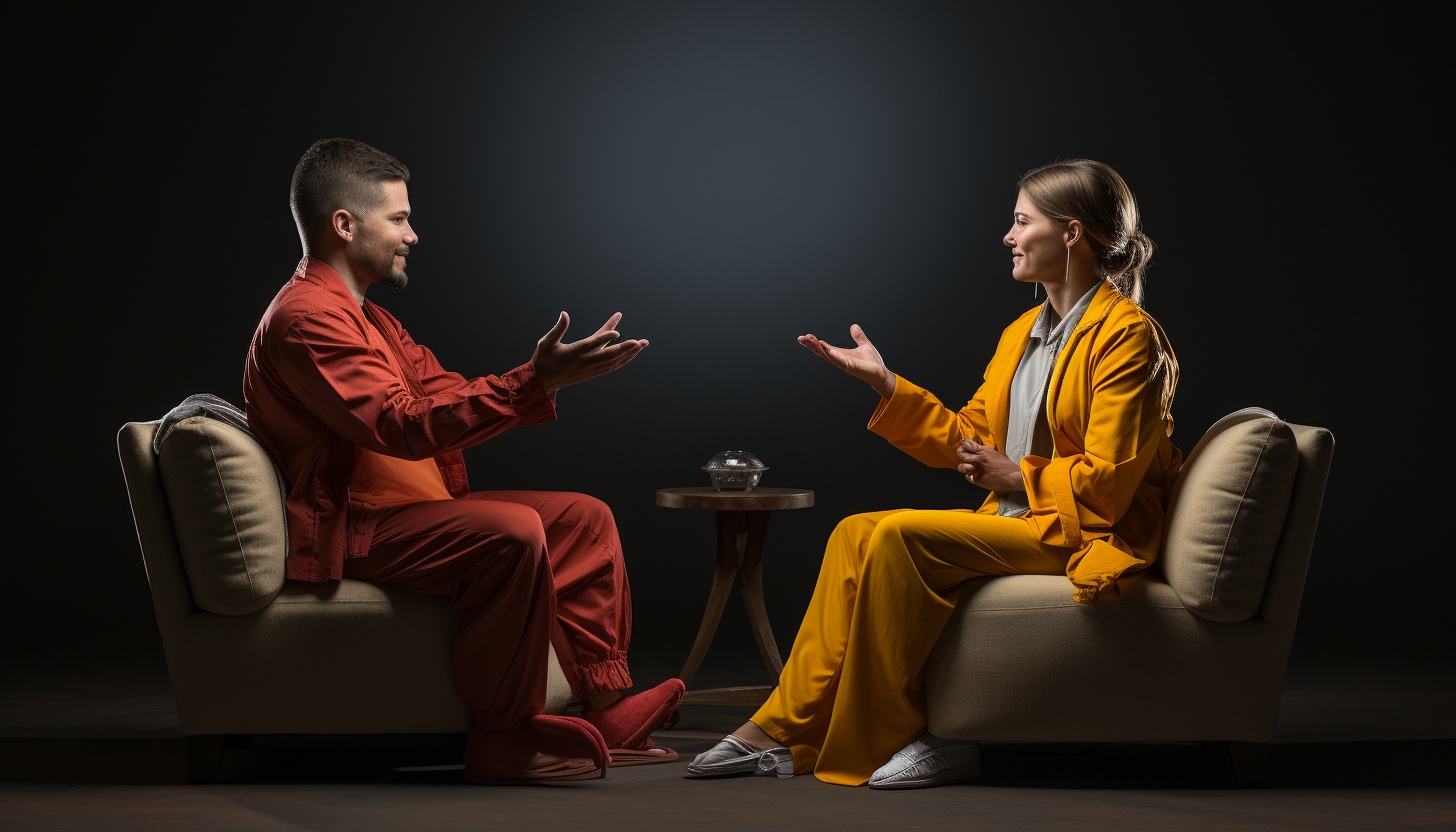
Mirroring and Matching: Building Rapport Through Body Language
Do you want to build better connections with others? Mirroring and matching can help.
Imagine this: you’re in a meeting with a potential client. As they lean forward and nod, you find yourself doing the same. Without even realizing it, you’re mirroring their body language, building rapport effortlessly.
In this article, we will explore the power of mirroring and matching, understand non-verbal communication, and provide techniques for implementing these strategies in your daily life.
Get ready to enhance your relationships through body language.
The Power of Mirroring and Matching

Mirroring and matching have a powerful impact on building rapport through body language. When you mirror someone’s body language, you subtly imitate their movements, gestures, and expressions. This technique can create a sense of familiarity and trust, as it signals to the other person that you’re on the same wavelength.
By matching their body language, you demonstrate that you understand and empathize with their emotions and experiences. Research has shown that mirroring and matching can lead to increased likability and cooperation between individuals. When you mirror someone’s body language, it can make them feel more comfortable and at ease in your presence. It can also enhance the quality of communication and understanding between people.
Furthermore, mirroring and matching can be used strategically in professional settings. When you mirror the body language of a potential client or business partner, it can help establish rapport and build trust. It shows that you’re attentive and responsive to their needs and preferences. This can greatly influence the outcome of negotiations, meetings, and collaborations.
Understanding Non-Verbal Communication

To truly build rapport through body language, it’s essential to grasp the intricacies of non-verbal communication. Non-verbal communication refers to the messages conveyed through facial expressions, gestures, posture, and other physical cues, rather than through spoken words. Understanding these non-verbal cues is crucial because they often reveal the underlying emotions, attitudes, and intentions of an individual.
One important aspect of non-verbal communication is body language. This includes the way we stand, move, and position ourselves in relation to others. For example, crossed arms may signal defensiveness or resistance, while open and relaxed postures indicate receptiveness and comfort. Similarly, eye contact can convey interest or disinterest, depending on its duration and intensity.
Another important element of non-verbal communication is facial expressions. Smiles, frowns, raised eyebrows, and narrowed eyes all communicate various emotions and attitudes. By paying close attention to these subtle cues, you can gain deeper insight into a person’s feelings and thoughts.
Mastering non-verbal communication allows you to better understand and connect with others. It helps you adapt your own body language to create a sense of rapport and trust. By observing and interpreting non-verbal cues, you can adjust your gestures, posture, and expressions to match those of the person you’re interacting with.
Understanding non-verbal communication is the foundation for effectively mirroring and matching. By mirroring someone’s body language, you can subtly mimic their movements and gestures to build rapport and establish a sense of connection. Matching, on the other hand, involves aligning your body language with theirs to create harmony and enhance communication.
In the next section, we’ll explore specific techniques for effectively mirroring and matching to further enhance rapport through body language.
Techniques for Mirroring and Matching

To effectively build rapport through body language, you can employ various techniques for mirroring and matching. These techniques involve subtly imitating the other person’s non-verbal cues to create a sense of connection and understanding.
Here are two sub-lists of techniques you can use:
Mirroring Techniques:
– Posture: Adopt a similar posture to the other person, whether it’s sitting or standing. This helps to establish a sense of harmony and mutual respect.
– Gestures: Observe the other person’s gestures and mirror them in a natural and unobtrusive way. This can involve matching their hand movements or facial expressions.
Matching Techniques:
– Tone of Voice: Pay attention to the other person’s tone of voice and try to match their pitch, volume, and speed. This creates a sense of familiarity and rapport.
– Breathing: Subtly synchronize your breathing with the other person. This can help establish a sense of calmness and connection.
By employing these mirroring and matching techniques, you can create a non-verbal dialogue that fosters trust and understanding. These techniques help to establish a sense of rapport and make the other person feel more comfortable and open to communication.
In the next section, we’ll explore the benefits of building rapport through body language.
Benefits of Building Rapport Through Body Language

Building rapport through body language offers several benefits that can greatly enhance your communication and relationships. When you mirror and match someone’s body language, you create a sense of familiarity and connection. This can lead to increased trust and understanding between you and the other person. By aligning your nonverbal cues with theirs, you demonstrate empathy and show that you’re actively listening and engaged in the conversation. This can help you establish a positive and harmonious atmosphere, making the other person feel more comfortable and open to sharing their thoughts and feelings.
Additionally, building rapport through body language can improve your persuasive skills. When you mirror someone’s gestures, postures, and expressions, you create a subconscious bond that makes them more receptive to your ideas and suggestions. This can be especially beneficial in professional settings, such as negotiations or sales pitches, where building rapport and establishing trust are crucial for success.
Moreover, mirroring and matching can also enhance your ability to influence and lead others. By adopting similar body language, you can create a sense of unity and camaraderie, making it easier for people to follow your lead and collaborate effectively. This can be particularly useful in team settings, where strong rapport and effective communication are essential for achieving goals and objectives.
Implementing Mirroring and Matching in Your Daily Life

You can easily incorporate mirroring and matching techniques into your daily interactions to build rapport through body language. By mirroring and matching the body language of others, you can establish a sense of connection and understanding.
Here are some practical ways to implement these techniques in your daily life:
– Observe and mimic: Pay attention to the body language of the person you’re interacting with and subtly mimic their gestures, posture, and facial expressions. This non-verbal mirroring can create a subconscious sense of familiarity and rapport.
– Match energy levels: Adjust your energy levels to match the other person’s. If they’re enthusiastic and animated, reflect that energy in your own body language. Conversely, if they’re more calm and reserved, adopt a similar demeanor. This can help create a harmonious and balanced interaction.
– Use mirroring during conversations: Mirror the other person’s speech patterns, tone, and pacing. If they speak slowly and softly, try to match their pace and volume. This can enhance the sense of connection and understanding between you.
– Be mindful of body language cues: Pay attention to the non-verbal cues that the other person is giving off, and respond accordingly. If they cross their arms, you may want to avoid invasive or confrontational topics. Mirroring their body language can help establish trust and openness.
Conclusion
In conclusion, mirroring and matching body language is a powerful tool for building rapport and enhancing communication. By consciously adopting similar gestures, postures, and facial expressions, you can create a sense of connection and understanding with others.
This non-verbal technique allows for better communication and helps to establish trust and rapport.
So, why not start incorporating mirroring and matching into your daily interactions and see the positive impact it can have on your relationships?






